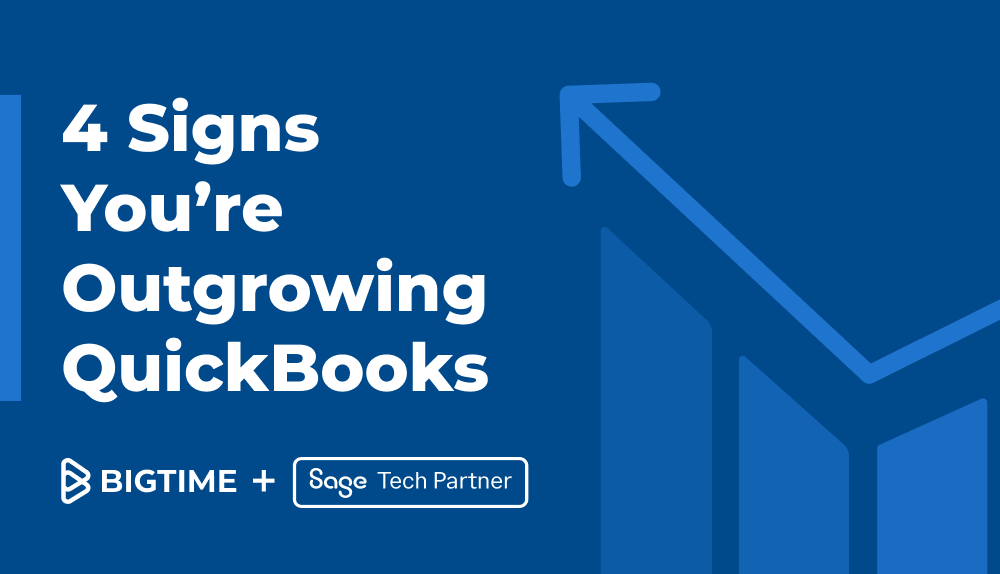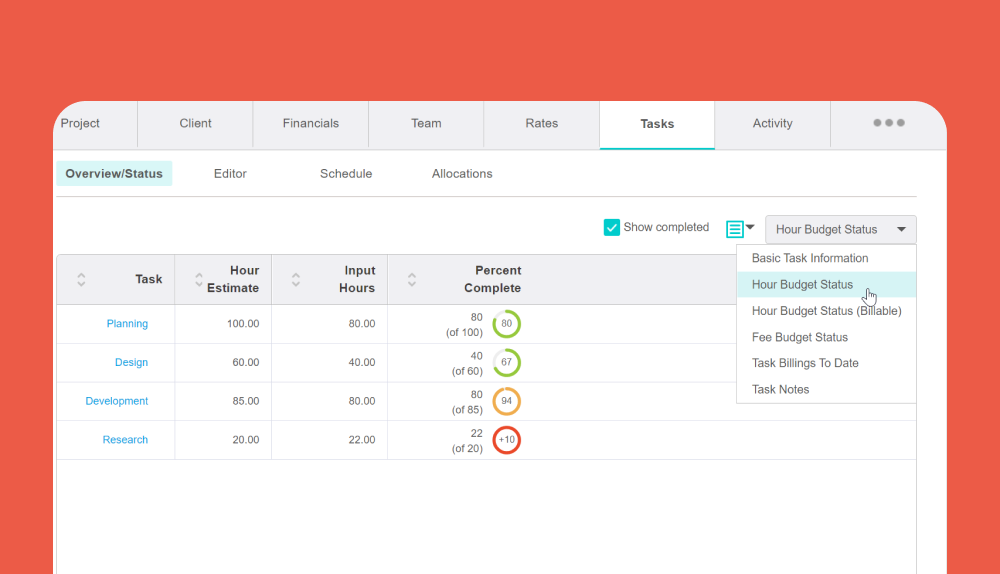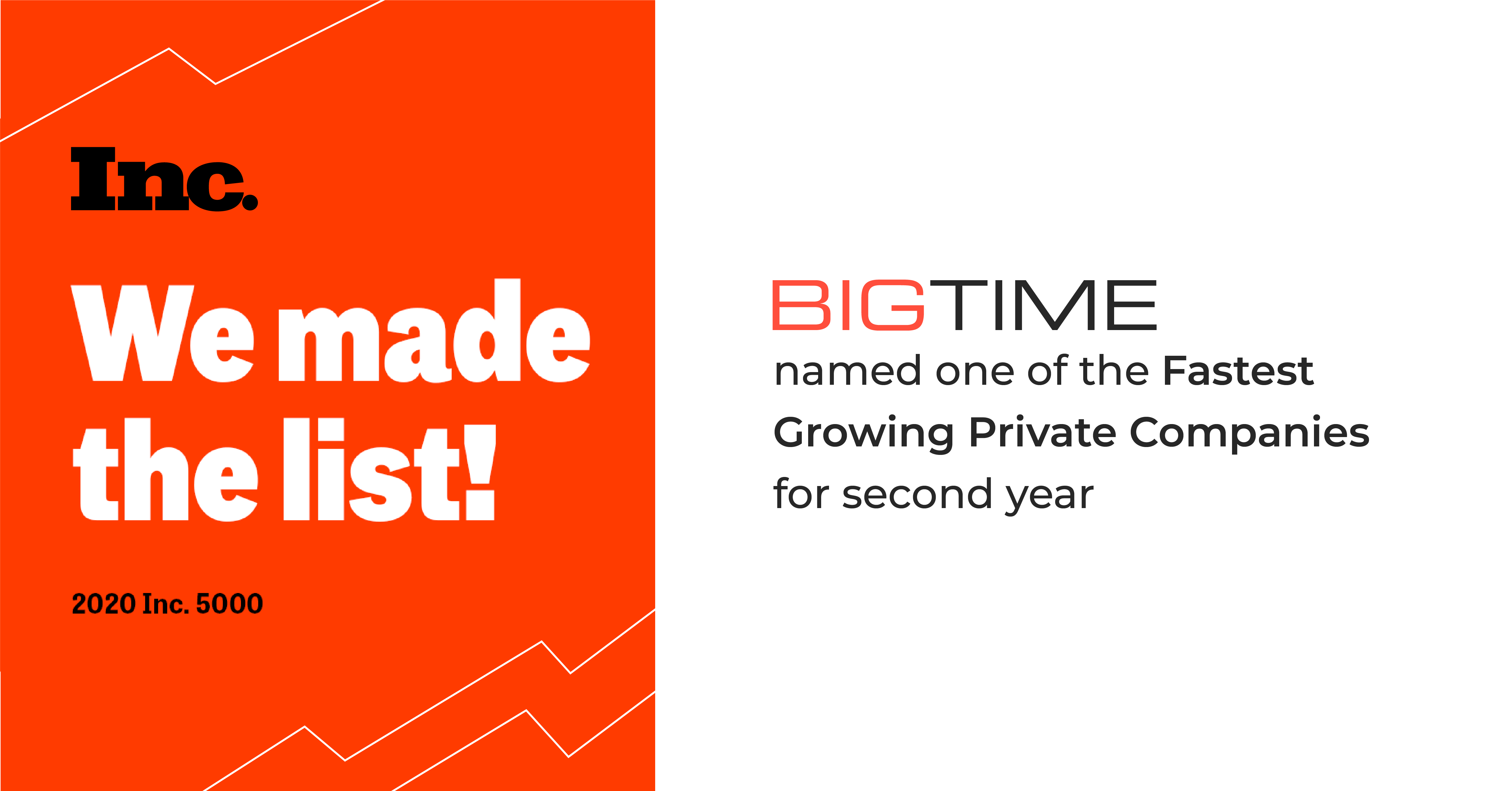Do you want to have a successful portfolio? All project leaders do – and project prioritization is the most straightforward way to achieve it.
Still, balancing people’s workload with limited budgets and huge customer expectations is easier said than done. However, the benefits of project prioritization outweigh the efforts, leading to efficient processes, higher profit margins and improved project delivery. Use our frameworks and battle tested approaches to enjoy all of those improvements – and more.
In this article, you will learn:
- The definition of project prioritization in portfolio management,
- The importance of the process,
- How to prioritize projects effectively,
- What are the common project prioritization criteria,
- What the benefits of project prioritization are.
- The common project prioritization methods.
What Is Project Prioritization? Definition
Project prioritization in professional services companies is a structured decision-making process used to evaluate and sequence projects based on a variety of internal and external factors.
In general, project prioritization considers factors such as strategic value, resource requirements, financial impact, client urgency, and potential risks to determine the best possible order of operations in an organization. As a result, this process allows project managers to to allocate limited resources—such as time, talent, and budget—to the most valuable initiatives that align with business objectives, helping companies scale and boost profits.
Why Should You Bother? Why Is Project Prioritization Important
Why is prioritization important in project management?
In a few words, project prioritization is what really makes your projects successful – and profitable. By using this process to focus on higher priority projects, project managers can enjoy:
- A complete strategic alignment in your business. Project prioritization helps allocate resources to the initiatives that deliver the greatest value and are consistent with organization’s strategic objectives, rather than spreading effort across disconnected or low-impact activities.
- Optimized resource allocation. By identifying the most important and impactful projects, organizations can allocate people, budgets, and tools more efficiently.
- Better stakeholder satisfaction. Focusing on high-value projects improves outcomes for key stakeholders—be they clients, executives, or end users. It also helps manage their expectations.
- Improved risk management. Prioritizing projects based on risk exposure—whether technical, financial, or operational—enables better mitigation planning and informed trade-offs between high-risk/high-reward and low-risk/steady-return initiatives.
- Increased project success rates. When prioritization is done effectively, teams work on the right projects at the right time—boosting clarity, motivation, and alignment. This often leads to better execution and a higher likelihood of successful outcomes.

How To Prioritize Projects with No Errors? A Complete Guide
Chaos is slowly creeping into your project portfolio, tampering with project completion? It means it’s time for project prioritization. Still, knowing when to prioritize operations it’s just a tip of the iceberg; project managers also need to know who to prioritize, and based on what criteria. Here’s how to do that.
1. Identify The Right Stakeholders for Prioritization Process
Hearing a lot of background noise? It is possible that not every voice should be heard in the prioritization process. To avoid prolonged discussions and constant changes, make sure that only key stakeholders have an impact on the final decisions. To do that, ask yourself the following questions:
- Do they have the authority and knowledge to make decisions regarding current and future projects, as well as organizational goals?
- Do they have any valuable insights the prioritization could benefit from?
- Will they face any challenges that might appear as a consequence of this process?
- Is their position relevant to the project discussed during prioritization?
If the answer to the majority of these questions is yes, the person in question is likely a stakeholder you should consider valuable for the prioritization process.
2. Strategic Alignment – Get Everyone On The Same Page
Choosing the right people for the prioritization process is one thing; getting them to work together towards common business goals is a very different story.
Before the work on project prioritization starts, clearly state:
- What is its ultimate goal? Are you aiming for a minor optimization or a brand-new plan for the next few months?
- How will the process be completed? Will you meet with all the stakeholders, or are you going to use project management software to manage operations asynchronically?
- Are there any constraints to consider? You might have a limited time to complete the project, or need to do it right away due to unforeseen circumstances.
3. Determine Prioritization Scope
Not all projects need to be prioritized – and it’s project managers’ job to determine which ones do.
Before the project prioritization process starts, make a list of all the items that need to be prioritized. The list doesn’t have to consist of all the projects your organization handles at the moment; it could only include billable or non-billable operations, projects for certain groups or customers, or projects working with the same resource pool. The selection criteria are endless, as long they leave you with a clear and concise list with no outstanding items standing in the way.
4. What Really Matters? Identify Project Prioritization Criteria
What matters most to your projects? That’s a question you need to answer before you try to put them in the right order. To do that, identify the prioritization criteria you are going to use throughout the process to determine the importance of individual operations.
In professional services, common prioritization criteria include:
- Return on Investment (ROI)
- Strategic alignment with firm’s strategic objectives
- Resource availability and utilization rates
- Revenue and profit potential
- Level of effort
- Time sensitivity
- Complexity and associated risks
- Client relationship
- Innovation.
Importantly, project managers shouldn’t just choose all of these criteria to get a bigger picture of the operations. This process involves evaluating them, too! Criteria should be carefully selected for each prioritization process based on their alignment with the company’s goals and other objectives important to your business.
5. Choose The Right Prioritization Framework
You don’t have to rely on a gut feeling to prioritize your projects – prioritization frameworks are here to help you.
These proven methods of prioritizing projects were designed to make the process as straightforward as possible. With their clearly defined constraints, results, and rules, they are also perfect for putting all of your stakeholders on the same page without reinventing the wheel – all while aligning your process with the company’s goals.
6. Prioritize The Work!
Now, all the preparations are complete, and you can now start to prioritize projects.
Whether you’re using a designated project management tool or just scheduling a meeting with all the stakeholders, you will need to:
- Define any unclear existing and potential projects on your project list.
- Review the list of strategic projects with all the stakeholders and cross out all the items that should not be a part of the process (if there are any left, of course!).
- Review the framework of your choice.
- Specify any obstacles and risk criteria you should consider in the process.
- Go through the item list with your stakeholders and start to prioritize!
7. Implement and Monitor the Prioritization Plan
While project prioritization might seem like the end of the journey, it’s just a beginning. After the meeting, share the final project plan with all the interested parties and start implementing the priorities accordingly.
Importantly, project prioritization is not a one-and-done! As the projects begin, end, and evolve, you might need to revisit your plans for important projects after some time to ensure they still can be reflected in the reality. Otherwise, you might miss some updates that are vital for your project success. To do that, regularly track progress with your leadership team to ensure that yoyr portfolio of projects is progressing as intented and achieve maximum value with minimal business risk.

Prioritization Frameworks – When and How To Use Them?
Assessing projects based on various criteria is a backbone of the project prioritization process. Still, if you want to organize projects with just a pen and a piece of paper, you’re definitely up for an enormous challenge. Fortunately, scoring models and project prioritization frameworks can help you tackle the issue with very little effort. Despite their differences, these methods have one thing in common: they will help you speed up the process and make the best decisions possible.
Let’s take a look at the most common prioritization frameworks and see how they can help you in your prioritization efforts.
MoSCoW Method
The MoSCoW method is a widely used prioritization framework in project management that helps teams and stakeholders categorize project requirements or tasks based on their importance and urgency. It was created by Dai Clegg, a software development expert at Oracle, who aimed to help prioritize his team’s work during releases – and his method is a perfect choice for that.
The acronym MoSCoW, which contains two extra Os, stands for four categories projects are divided into in this prioritization framework. Those include:
- Must Have, or non-negotiable requirements or tasks that are critical for the project’s success. They usually include deliverables, contractual obligations, or essential products and features.
- Should Have, or requirements that add significant value and improve project performance but are not essential for initial delivery. These usually are performance enhancements, reporting or automations.
- Could Have, or items that are desirable, but not necessary, such as minor requirements or cosmetic enhancements.
- Won’t Have (this time), or items that are explicitly not being delivered in the current scope or release. This helps manage stakeholder expectations and reduces scope creep.
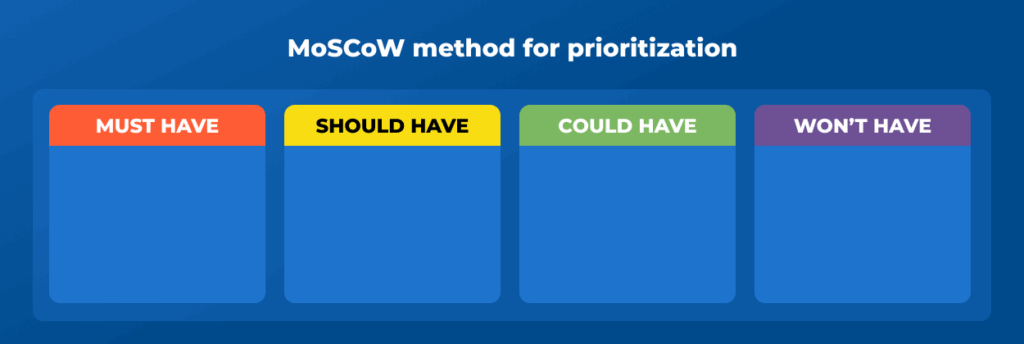
But when should the MoSCoW method be a go-to solution? This prioritization framework works best for:
- Strategic planning for a project kickoff,
- Managing conflicting stakeholder demands
- Resource-constrained project delivery
- Agile or iterative development cycles – it was created with such an approach in mind!
Eisenhower Matrix
The Eisenhower Matrix, also known as the Urgent-Important Matrix, is a simple yet powerful decision-making tool used for strategic prioritization based on two key dimensions: urgency and importance. Named after U.S. President Dwight D. Eisenhower—who was known for his productivity and decision-making—the matrix helps professionals and organizations focus their time and resources on high-value activities.
The matrix is divided into four quadrants, each representing a different level of priority and action:

Each quadrant suggests a different course of action for the assigned projects. For example, projects that are:
- Urgent and important should be completed right away, as they are both time-sensitive and critical to success. These tasks usually include deadlines, crises, or compliance issues.
- Important but not urgent should be scheduled. While these tasks (including, for example, planning, training and process improvement) have a significant impact on project delivery methods, they can be completed later on.
- Urgent, but not important, should be delegated. According to this framework, non-critical projects such as routine reporting and administrative tasks that can distract specialists from their main goals, should be completed with different resources.
- Not urgent and not important should be eliminated. These tasks are purely a distraction and they should not secure a spot on the list of your priorities.
When is using the Eisenhower matrix the right choice? If you need to quickly separate tasks and projects based purely on their impact and importance, this project prioritization matrix will certainly help you. It is also a perfect tool for cooperating with stakeholders with different opinions and priorities, or numerous project requests wit no clear constraints. However, if you’d like to add other factors to the equation, this matrix might not be complex enough for you.
Value vs Effort Matrix
The Value vs Effort Matrix—also known as the Impact-Effort Matrix or Quick Wins Matrix—is a visual prioritization tool used to assess and compare projects or tasks based on two key dimensions:
- Value (or impact): The expected benefit to the business or client.
- Effort: The estimated amount of time, cost, or resources required to complete the work.
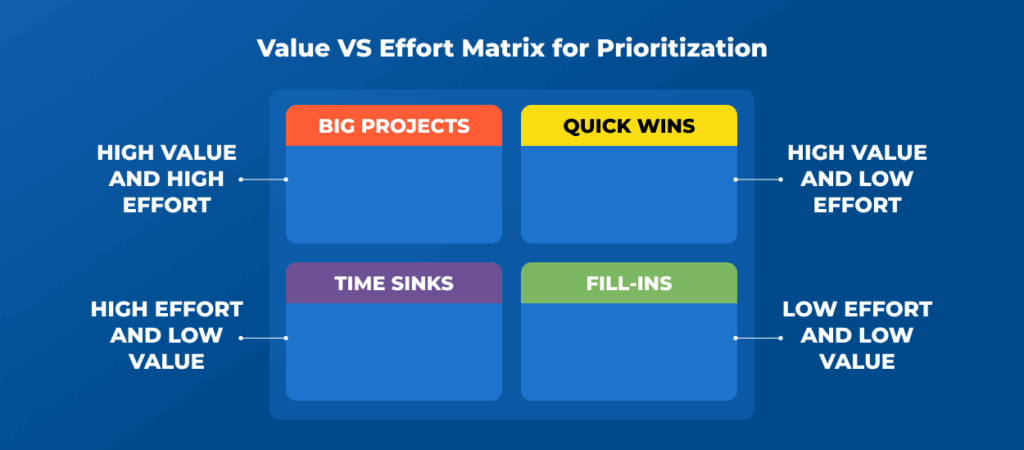
As a result, the matrix divides the projects into four categories, similarly to the Eisenhower matrix:
- Quick Wins – projects that offer strong returns with minimal investment, for example automations, resolving recurring issues or creating templates for repeatable tasks.
- Big Projects, or projects that require substantial resources but yield significant benefits. They usually include brand new products and services, system migrations or process redesigns.
- Fill Ins – the tasks that are easy to complete but don’t contribute meaningfully to business or client objectives, such as cosmetic updates or internal operations.
- Time Sinks or Time Wasters. Projects that consume significant time and resources but offer little strategic or financial return.
Still, this prioritization method poses a significant challenge. While value should align with the company’s objectives, the positioning framework itself doesn’t specify the definition of an effort. Therefore, identifying such a definition for your business is vital for the success of this prioritization method.
But who can benefit from using the Value vs Effort matrix? It is best suited for project planning and managing internal processes, including creating new products. Still, due to the differences in definitions, it might not be a good answer to complex project prioritization issues.
The Kano Model
The Kano Model is a customer-centric framework used in project prioritization to evaluate and categorize features, services, or project outcomes based on how they affect customer satisfaction. Developed by Professor Noriaki Kano in the 1980s, it provides a structured way to distinguish between basic expectations, performance factors, and delight-driven innovations. However, this prioritization framework requires extensive research to be successful and might be too time consuming for those looking for quick results.
Based on the Kano Model, projects are divided into the following categories:
- Must-be (or Basic Needs) – Fundamental features or requirements that clients take for granted.
- One-dimensional (or Performance Needs) – Features that improve satisfaction in direct proportion to their presence or quality.
- Attractive (or Delighters) – Unexpected or innovative features that pleasantly surprise clients.
- Indifferent – Features that neither add to nor detract from customer satisfaction.
- Reverse – Features that may cause dissatisfaction if present, depending on the customer segment.
After the projects are categorized, project teams should focus on Must-Be operations to ensure project success. Then, they can move on to performance needs and attractive features and maximize their share of work whenever possible. On the other hand, indifferent and reverse projects should be crossed out of your project list to avoid waste.
Why should you use this prioritization framework? If your services always put customers first, the Kano model will help you fulfill their expectations as closely as possible. Still, this method is definitely the most time-consuming of them all due to the need for extensive initial research. So, if you’re looking for quick fixes, you might be interested in other project prioritization frameworks!
Scoring Model
A scoring model for project prioritization is a quantitative decision-making tool that evaluates and ranks projects based on a set of predefined criteria, each with assigned weights and scoring scales.
Still, before the scoring model is used for prioritization in your company, you need to identify its key components for your business. Those components include:
- Evaluation criteria, or the dimensions by which each project is assessed. They generally include strategic alignment, project value, financial return, associated risks and available resources.
- Scoring scale, usually 1-5 or 1-10, where higher scores reflect greater value or priority.
- Weighting. Criteria are assigned weights to reflect their relative importance. For example, strategic alignment might be weighted more heavily than innovation in a given planning cycle.
- Total score calculation. The score for each project is calculated as the sum of weighted scores across all criteria.
After a score is calculated for each of the existing projects, the projects are ranked from the best to the worst, giving the project managers a clear overview of their portfolio. You can see an example of such a project prioritization matrix below.
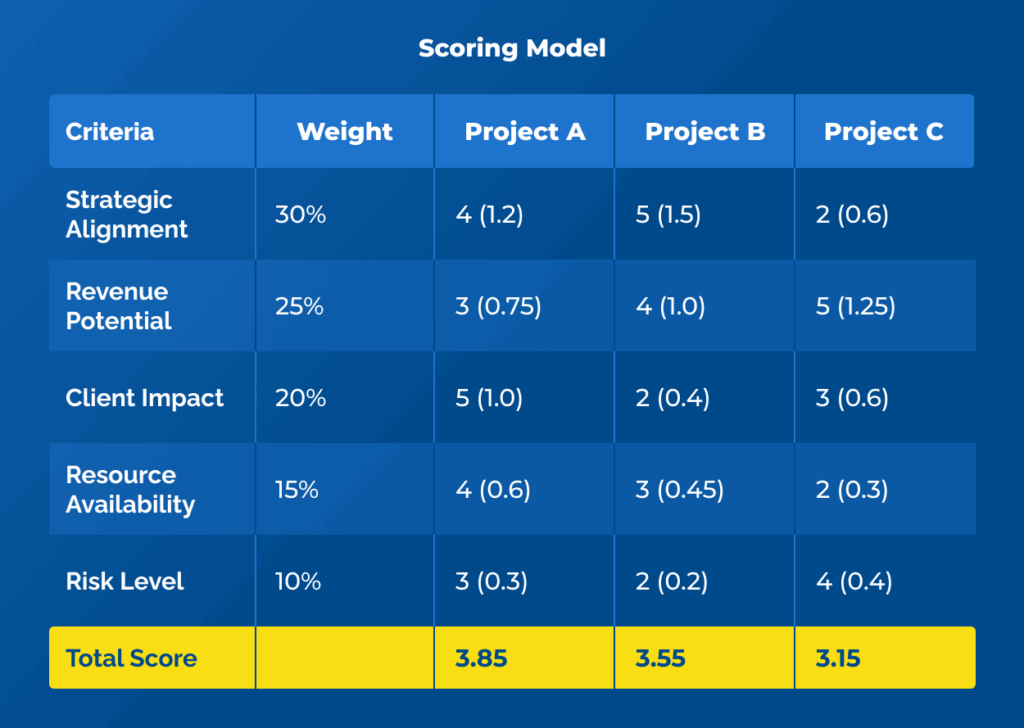
Project Prioritization Example – Project Prioritization Matrix
Don’t know where to start? Start with a project prioritization matrix template you’ll find below.
Imagine you work at a consulting firm supporting a regional bank with multiple digital initiatives. The bank has limited capacity and has asked you to help prioritize three projects: launching a loan origination platform, developing a customer analytics dashboard, and upgrading legacy compliance systems.
To guide the decision, you create a scoring model using five criteria: Strategic Value, Revenue Potential, Regulatory Risk, Customer Impact, and Feasibility. Strategic value and regulatory risk are deemed most important, each weighted at 30%, while the other three are weighted at 13.3% each. Each project is scored on a 0–10 scale.
Here’s the scorecard after input from stakeholders:
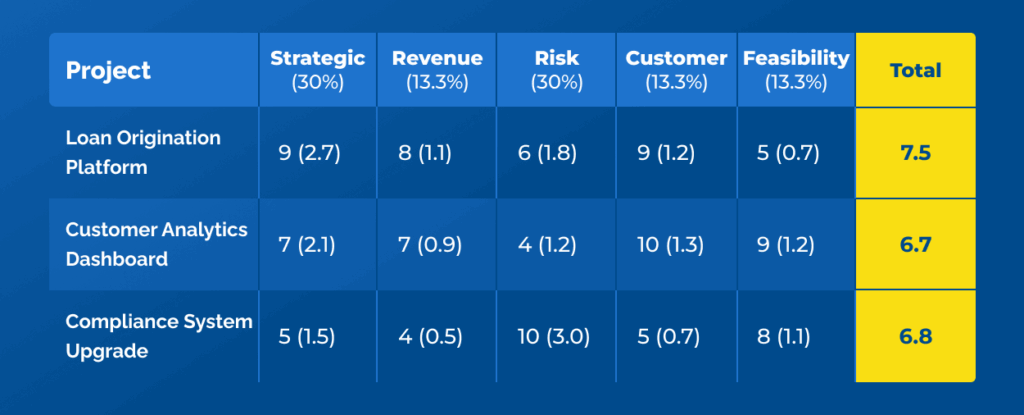
Based on the total weighted scores, the Loan Origination Platform should be prioritized first due to its strong alignment with strategy and revenue impact. The Compliance Upgrade, while less strategic, scores high due to regulatory urgency. The Analytics Dashboard is promising but less urgent, making it ideal for later implementation.
Common Mistakes in Project Prioritization (and How To Avoid Them)
Unfortunately, the project prioritization process sometimes goes sideways for various reasons. The good news is that you can prevent that from happening. Here are a few things you might want to avoid in the process.
Lack of clear criteria
When teams rely on vague, inconsistent, or informal standards, prioritization becomes subjective and highly prone to bias. This lack of structure makes it difficult to compare projects objectively and often results in decisions driven by personal preferences, legacy practices, or incomplete information. Without clarity, alignment breaks down, and prioritization decisions fail to reflect strategic goals or business value.
Listening to the loudest stakeholders
Another frequent pitfall is allowing the most vocal stakeholders to dominate the prioritization process. These individuals or groups may push their preferred projects aggressively, regardless of broader business priorities or actual value. While stakeholder input is essential, overemphasizing the influence of those who shout the loudest can distort prioritization and lead to misaligned initiatives.
Overcommitting resources
Organizations often approve a wide array of initiatives without fully considering whether their teams have the capacity, time, or skills to deliver them. As a result, progress slows across the board, quality suffers, and deadlines slip. Overcommitting creates resource bottlenecks and burnout, undermining both individual projects and the broader portfolio. Prioritization must be coupled with honest assessments of resource availability to be effective.
Failing to reassess priorities
Project priorities are not static. Business environments, market conditions, and internal capabilities evolve—sometimes rapidly. A common mistake is treating prioritization as a one-time exercise rather than a dynamic, ongoing process. When priorities are not regularly reviewed and adjusted, teams may continue to invest in low-impact projects or miss opportunities to pivot toward higher-value work.
Unclear definition of success
Teams may pursue different goals under the same project umbrella, and stakeholders may evaluate outcomes inconsistently. Without clear success metrics—whether financial, operational, or customer-focused—it’s nearly impossible to measure impact or learn from outcomes. Effective prioritization requires not only the project selection process but also defining the value they are expected to deliver.
Tools For Managing Priorities? BigTime Has Them All!
Managing multiple projects is not a piece of cake. Still, with BigTime’s project prioritization system, it can become just a simple formality.
In BigTime, you can instantly see all of your projects, their status and budgets, and make changes by simply dragging and dropping allocations and operations – and it all can be done in seconds. If you’re not exactly sure what’s the best way to proceed, you can also test our different scenarios and make the optimal decisions – every time.
Try BigTime now or book a demo to manage priorities in seconds, not in days!


